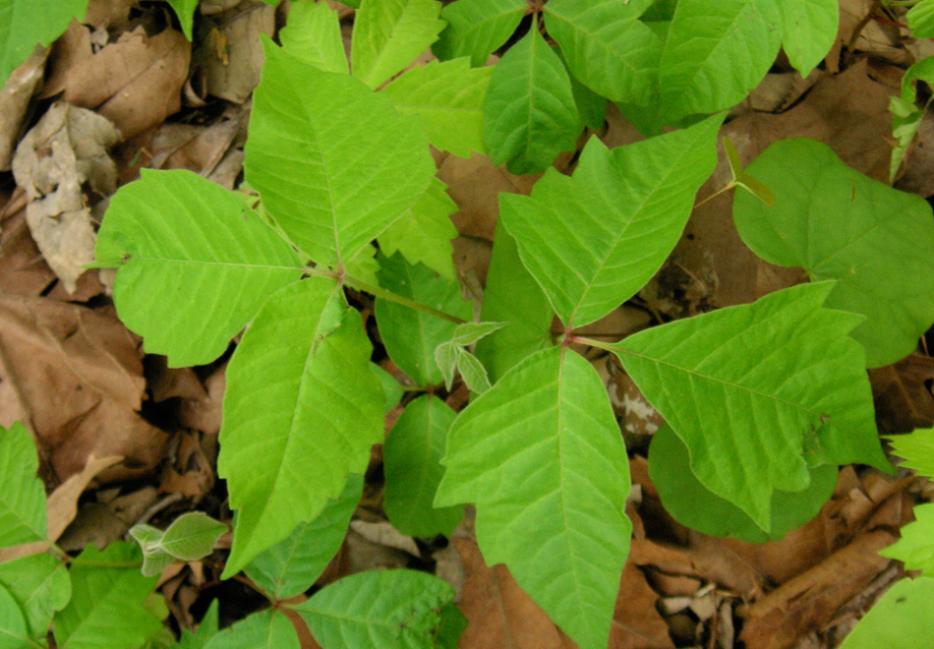Through the morning mist, his horns curl back like twin sticks whittled for goring. Against the emerald cacophony of a forest surging into a late spring dawn, his black fur gleams with dew as hot breath unfurls from the ebony archways of his nose. His mouth lurches in sick and even rhythm; bite, chew, chew, chew, bite, chew, chew, chew. Later, a forester will come to collect this tiny baphomet of the wilds, their human arms sheathed in protective coverings, their hairless, human body shielded from something unseen. The light catches the goat’s irises, those dark, rectangular pools reflecting back a trio of shiny, green leaves.
Poison ivy.
It’s a scene that unfolds daily—a fight against the prodigious plant that so blithely blisters those unfortunate enough to brush it. (Goats, unperturbed, find it delicious.) Reddish in the spring and fall, green in the summer, poison ivy expands its kingdom with insidious efficiency, its roots sunk deep into the earth. In the winter, the brown vines stick out on the sides of tree trunks like a hairy, dormant rope of pain. There’s really no other way to say this: poison ivy is metal as fuck.
These dread leaves of three, like their brethren poison oak and poison sumac, owe their misery-inducing powers to urushiol, a group of compounds found in the fatty oils, or resin, of the plant. And trust: urushiol is nasty stuff. It’s the reason “raw” cashews sold in stores and markets are actually steamed. It’s found in the sap of mango trees, able to unexpectedly bring chaos to the lips when one sucks yellow pulp from the rind. Rub across its roots and skin riots in the aftermath; burn it in a brushfire and inhale the smoke at your mortal peril. More than half of people will suffer its itch and burn, weeping and crusting each time they come into contact with urushiol, their skin transforming into a dermatological hellscape at the merest brush with a leaf. Think you’re safe because you’ve never gotten poison ivy? Wrong. You can develop a sensitivity to urushiol at any time—and reactions often grow more dramatic with repeat exposure.
Once in the skin alongside the not-technically-dangerous novelty bits, the T cells go full berzerker, unleashing cytokines and a flood of cytotoxic damage, initiating with their signaling proteins a chain of events that ends in a strikingly awful rash. Like chicken pox, but more extroverted.
That’s not even the worst part. As the most allergic genus of the family Anacardiaceae, Toxicodendron and its trio of toxic species do not play nice with the human body, but that’s more the fault of the host than anything else. Urushiol isn’t actually toxic at all. It’s your body’s own stupid fault, you see, and that whole rash is crying wolf.
Urushiols are also known as the pentadecylcatechols, which consist of 1,2-dihydroxy benzenes with a 15-atom side chain in the 3rd position (3-pentadecylcatechol, if you remember your organic chemistry or are an insufferable know-it-all at parties). It’s found in the leaves, stems, and roots of the plants, and to many animals—such as our helpful goat friend—it offers no malice. A goat eating T. radicans has a nice snack; a human doing the same has a 50-70 percent chance of potentially life-threatening poison ivy all over their gastrointestinal tract, from top to weeping, itchy, ulcerated tailpipe.
So how does a harmless plant turn human skin into a lush collective of fluid-filled orbs?
When urushiol penetrates our skin, our body metabolizes it into frisky little quinone derivatives. These component parts aren’t actually dangerous either—but, mingling with your skin, the quinone compounds start binding to area proteins, keratin in particular. Normally one to mind its own business as a structural protein, forming the fibrous matrix of things such as skin and hair, keratin is now stuck in a strange and terrible lump with the deceptively friendly plant catechols. The quinone is a hapten— a small molecule that can only trigger an immune response when attached to another, larger carrier (i.e., keratin)—and the sight of this urushiol-derivative/skin protein coupling spooks the shit out of your immune system. One second it was all clear with some chill-ass quinones, the next it was David Cronenberg’s gritty reboot of The Blob. Your body, which was already pretty squeamish after his amputee erotica, cannot accept these new molecular love-birds. And so, it unleashes a war.
The doom blobs are captured by Langerhans cells, which drag them in front of a tribunal of T cells for inspection in the lymph nodes. Sensing a threat and sounding the alarm, the T cells march an army back to the site of the offending plant matter. Once in the skin alongside the not-technically-dangerous novelty bits, the T cells go full berzerker, unleashing cytokines and a flood of cytotoxic damage, initiating with their signaling proteins a chain of events that ends in a strikingly awful rash. Like chicken pox, but more extroverted.
So go on, cheerful camper, and enjoy your flesh in revolt—that red and blistered mockery of man’s fragile dominion over nature—because it really doesn’t get much better from here.
It doesn’t take much. As little as 50 micrograms of pure urushiol—less than the size of one grain of table salt—is enough to trigger this delayed hypersensitivity reaction in 80-90 percent of adults. The contact dermatitis usually erupts two to four days after exposure, but just to keep things extra confusing, it sometimes takes as long as two weeks for the telltale demon itching to emerge. And it is a fiendishly itchy rash, the kind that begs you to pour scalding hot water over it; the kind that says impetigo is worth the ecstasy of sharp fingernails and relief.
The rash even sounds bad when scientists describe it:
“It is characterized by intense pruritus and an erythematous reaction followed by the appearance of multiple papules and vesiculo-bullous lesions in a linear distribution (Figure 7). The face, neck, and genitalia are commonly affected and usually show intense oedema”
Translation: this rash itches like an ancient curse from the dark forest lords, turning the flesh blood red before bunches of firm, hideous lumps and grotesque, golden bubbles rise up from within the skin itself. Delicate places—the kinds receptive to, say, other people’s mouths—are the most commonly affected; there is a fuck-ton of doomsday swelling.
So go on, cheerful camper, and enjoy your flesh in revolt—that red and blistered mockery of man’s fragile dominion over nature—because it really doesn’t get much better from here.
The fallout from your hyperactive boy scout of an immune system results in a rash that usually clears itself up in a week or two, but can last as long as six, and there ain’t shit we can do about it. Treatment and prevention options are limited; there is no IgE antibody involvement, which means antihistamines and allergy immunotherapy are powerless in the face of this woodland creeper. (As noted in the 2001 edition of Primary Care Pediatrics, “though they have no effect on the type 4 immune response, antihistamines may provide some relief from itching. This effect is probably due to medication-induced somnolence.” In other words, they make you too stoned to scratch.) For severe cases, treatment consists of corticosteroids to blunt the immune response. You’re just doing all of this to yourself, body.
It’s pleasing, then, in a richly ironic literary sense, that poison ivy fucking loves climate change.
According to a 2008 study conducted over six years at the Duke University FACE site, an experimental loblolly pine plantation in North Carolina, poison ivy plant biomass increased significantly in an elevated CO2 environment (much like the one we are careening towards as we humans cook the planet) compared to the biomass of poison ivy grown at ambient CO2 levels. And not only did they observe that increased atmospheric carbon boosted photosynthesis and water usage by the plants, they also saw increased urushiol levels.
Fantastic.
So, whether you’re drowsily stumbling up a nature trail on an early morning hike with your Nan, or launching a rent-a-goat program to supplement your biannual blood sacrifice to the forest demon urushiol, remember: leaves of three, let them be—because sometimes, it’s not just a beefy red swath and lemonade-yellow oozing. Sometimes, you find yourself with a swollen, seeping rash hidden beneath black lacquer, dark oily patches marring your flesh, inky blotches the pigment of corpse paint. See, when concentrated urushiol comes into contact with the air, the resin turns black when exposed, be it on a plant or the back of an arm, resulting in the rare and horrible black-spot poison ivy dermatitis. In three days, the blackness starts to shine like spilled nail polish. It cannot be washed off. In fact, there is nothing to do but wait for the onyx kiss of the forest underbrush to peel away from the skin on its own.
I told you T. radicans was fucking metal.
Black Metal Science is your regular reminder of the endless ways in which your body and nature can betray you, brought to you by Leigh Cowart.
Leigh Cowart is a freelance journalist and former NSFWCORP Sex and Science Editor. Her work has appeared in The Verge, Vice, Deadspin, The Classical, Sports On Earth, Silkwords, and the International Journal of Plant Sciences, among others. She was once vaccinated for rabies and has been drunk with power ever since.






